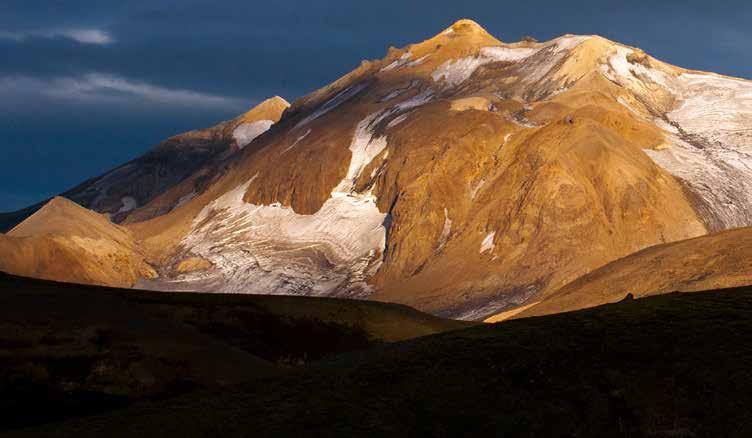
4 minute read
The Threat From Iceland

It is only a little over two hundred years ago that a volcanic eruption in Iceland, which lasted for eight months, devastated the entire northern hemisphere. We know that about a fifth of all Icelanders, almost ten thousand people, died in the Skaftáreldar eruption but it wasn’t until recently that we realized that this eruption caused terrible consequences in many parts of the world, both in the neighbouring countries and in regions far away.
When examining the sources, it has become clear that Skaftáreldar, the eruption that is often attributed to the Laki volcano, directly and indirectly killed about six million people. Millions of people died in Europe and the Americas, including indigenous people across North America. Almost two million Japanese died and a large number of people in China. It all started on a Sunday in the east in Skaftafellsýsla. The Reverend Jón Steingrímsson describes this in his remarkable diary:
“In the year 1783, on June 8th, which was the feast of Whitsun, in fair and sunny morning weather, a black sand mist and a cloud of soot appeared to the north of the nearest residential mountains on Síðan. In a very short time, it spread over the whole of Síðan.” Jón describes how animals stopped being able to eat, became miserable and died. The people died, either from suffocation or after



eating food poisoned by the eruption. In the following weeks, many fissures opened and, when it was at its peak, it is estimated that 6,000 cubic metres of glowing lava erupted every second, which is about twenty times the average flow of the Ölfusá river. The sheet crack was 27 km long and in it there were at least 135 craters of all shapes and sizes.
At this time in most countries, a lot of diaries and chronicles were written, offering an insight into the lives of the writers and their communities. Newspapers were published in many cities of the world and they reported on the weather and changes in nature. From all this data you can see what consequences the eruption in Iceland had on people’s lives in the most unlikely places and how it spread its dark claws over one country after another. Everywhere, as far south as the border of Mexico, N. Africa, N. India and Central China, it became dark for a long time and the sun became red as blood at sunset. The pyroclastic cloud reached Norway, Scotland and the Faroe Islands on the 10th June, just two days after the

eruption began. The grey fog of ashes had arrived in England on the 22nd June and, by the 24th, the fog covered all of Europe, as far east as the Adriatic Sea. In the month of July, the lack of sun and the volcanic ash began to have consequences in Russia, Siberia and China. Reports of unusual droughts came from India and the Yangtze region in China, where extreme cold was also experienced throughout the country in the summer of 1783. The Gray Fog (Gráaþokan), as it was often called, had a great effect on the nature in Syria and Egypt that summer and the annual monsoon rains failed. The result was a severe water shortage and famine. In January 1785, a sixth of the then population of Egypt had either fled the country or died.
On the east coast of the United States, the winter of 1784 was five degrees Celsius colder than usual. In the harbour of Charleston, Virginia, you could skate on the ice. Ice floes moved down the Mississippi and there were ice floes in the Gulf of Mexico. At its worst, the volcanic ash, or igneous rock in the upper atmosphere, covered a quarter of the entire earth, or the entire northern hemisphere down to the 30° latitude. Its impact on the environment and weather conditions was great and devastating for the next two years. Since the grey fog became persistent in Europe and elsewhere, it is estimated that up to a thousand kilograms of sulfuric acid (H2SO4) fell on every square kilometre of land in the first five months of the Skaftár fires.
This scenario affected crops in Europe for many years. The ensuing famine caused great social unrest and riots. About one million French people starved to death during this time. It is also widely accepted that the French Revolution had its roots in the aftermath of the Skaftár fires. It is not considered unlikely that an eruption of this magnitude in Iceland today would have an equally huge impact around the world and possibly halting all flights in the northern hemisphere for a whole year or more!
Many generations have passed since the Skaftáreldar eruption and time heals all wounds. Conditions at Laki were, at that time, as hostile to all life as can be imagined. Poisonous ash and fumes floated over the land, but now, more than two centuries later, soft beds of moss cover the rough lava, and crater walls and cooled lava flows shelter life. The craters at Laki and the surrounding lava are one of nature’s artistic gardens. There are mosscovered craters of all shapes and sizes, some of them having either clear or bluegreen ponds. In some places, beautiful short vegetation thrives in the shelter of the crater walls.











